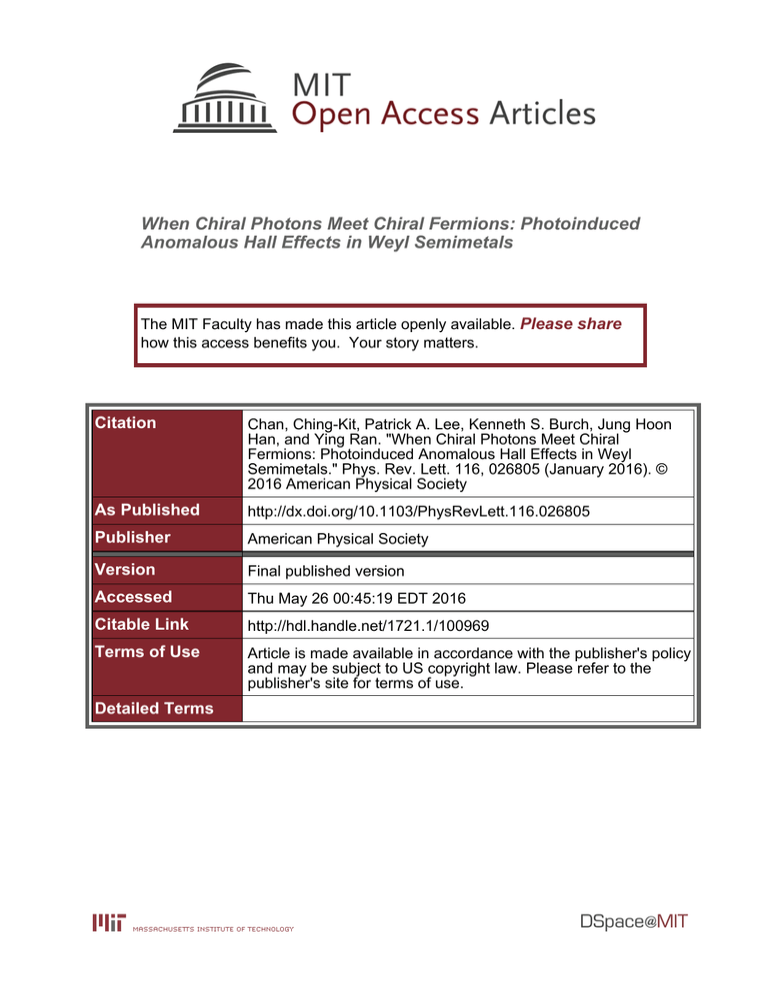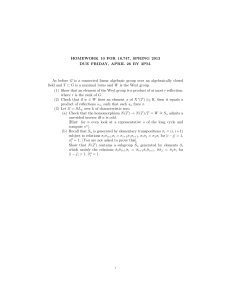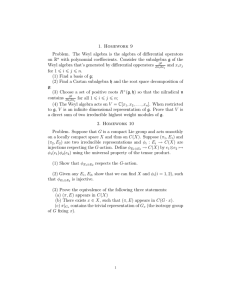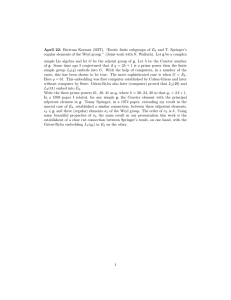When Chiral Photons Meet Chiral Fermions: Photoinduced Please share
advertisement

When Chiral Photons Meet Chiral Fermions: Photoinduced Anomalous Hall Effects in Weyl Semimetals The MIT Faculty has made this article openly available. Please share how this access benefits you. Your story matters. Citation Chan, Ching-Kit, Patrick A. Lee, Kenneth S. Burch, Jung Hoon Han, and Ying Ran. "When Chiral Photons Meet Chiral Fermions: Photoinduced Anomalous Hall Effects in Weyl Semimetals." Phys. Rev. Lett. 116, 026805 (January 2016). © 2016 American Physical Society As Published http://dx.doi.org/10.1103/PhysRevLett.116.026805 Publisher American Physical Society Version Final published version Accessed Thu May 26 00:45:19 EDT 2016 Citable Link http://hdl.handle.net/1721.1/100969 Terms of Use Article is made available in accordance with the publisher's policy and may be subject to US copyright law. Please refer to the publisher's site for terms of use. Detailed Terms PRL 116, 026805 (2016) week ending 15 JANUARY 2016 PHYSICAL REVIEW LETTERS When Chiral Photons Meet Chiral Fermions: Photoinduced Anomalous Hall Effects in Weyl Semimetals 1 Ching-Kit Chan,1 Patrick A. Lee,1 Kenneth S. Burch,2 Jung Hoon Han,3,* and Ying Ran2,† Department of Physics, Massachusetts Institute of Technology, Cambridge, Massachusetts 02139, USA 2 Department of Physics, Boston College, Chestnut Hill, Massachusetts 02467, USA 3 Department of Physics, Sungkyunkwan University, Suwon 440-746, Korea (Received 27 September 2015; revised manuscript received 17 November 2015; published 15 January 2016) The Weyl semimetal is characterized by three-dimensional linear band touching points called Weyl nodes. These nodes come in pairs with opposite chiralities. We show that the coupling of circularly polarized photons with these chiral electrons generates a Hall conductivity without any applied magnetic field in the plane orthogonal to the light propagation. This phenomenon comes about because with all three Pauli matrices exhausted to form the three-dimensional linear dispersion, the Weyl nodes cannot be gapped. Rather, the net influence of chiral photons is to shift the positions of the Weyl nodes. Interestingly, the momentum shift is tightly correlated with the chirality of the node to produce a net anomalous Hall signal. Application of our proposal to the recently discovered TaAs family of Weyl semimetals leads to an orderof-magnitude estimate of the photoinduced Hall conductivity which is within the experimentally accessible range. DOI: 10.1103/PhysRevLett.116.026805 Introduction.—Previously thought to be an asset exclusive to massless elementary particles such as photons, chirality has now become a defining emergent property of electrons in such crystalline materials like graphene [1] and the surface of topological insulators [2]. An exciting new addition to the growing list of “chiral electronic materials” is the Weyl semimetal [3–7]. In this three-dimensional analogue of graphene, the Weyl nodes act as magnetic monopoles in momentum space [8]. In sharp contrast to the two Dirac nodes in graphene that behave more or less as separate low-energy degrees of freedom, a pair of Weyl nodes carrying opposite chiralities are inherently tied together in a nonlocal manner through the “chiral anomaly” mechanism which allows the dissipationless transfer of charge between them [9]. The subject has undergone vigorous research lately due to reports of material predictions, followed immediately by their synthesis and confirmation of their Weyl characters by photoemission experiments and nonlocal transport measurements. A striking example of success along this line in recent years is the transition metal monophosphide family that includes TaAs, TaP, NbAs, and NbP [10–19]. In light of the rapid maturity of the Weyl semimetal research, one should ask whether the unusual electronic transport properties in both the static and dynamic regimes of the Weyl semimetal can be exploited in high speed electronics or to provide a new means of revealing dynamic topological effects [18–20]. It was recently suggested that exposing a two-dimensional Dirac material to a circularly polarized (CP) light could lead to a novel form of Hall effect due to the effective gap opening at the Dirac point [21,22]. A natural question arises as to what happens when 0031-9007=16=116(2)=026805(5) the three-dimensional, linearly dispersing bands of electrons couple to an intense CP light, as schematically presented in Fig. 1, and whether a nontrivial Hall effect can be induced. Here we present a direct consequence of coupling CP light to the Weyl fermion: the appearance of the anomalous Hall effect (AHE). In this work, we show that even when the AHE is absent due to symmetry reasons in typical Weyl materials, it must be generally present in all Weyl systems when coupled to a CP light source. Based on a low-energy effective WeylFloquet Hamiltonian analysis and symmetry considerations, we discuss the induced AHE as a generic and readily FIG. 1. Schematic figure for a driven Weyl semimetal. Blue ðIÞ and red circles indicate Weyl nodes with opposite chiralities χ W . The node positions are shifted by the chiral photons in a chirality-dependent manner and the shift is proportional to the square of the driving amplitude A. As a result, even though the total momentum shift along the driving direction is zero P ðIÞ ( I Δkz ¼ 0), the overall Chern vector shift has a finite zP ðIÞ ðIÞ component (δνz ¼ I χ W Δkz ≠ 0), resulting in a photoinduced anomalous Hall conductivity σ xy [see Eq. (6)]. 026805-1 © 2016 American Physical Society PRL 116, 026805 (2016) observable phenomenon in Weyl semimetals. We further demonstrate this effect using a concrete microscopic model, and apply our study to the TaAs family of Weyl semimetals with an estimation of the experimental feasibility. Other interesting works have addressed the driven threedimensional Dirac electrons [23,24] or gapped systems [25,26]. However, neither systems enjoy the unique topological protection of the Weyl nodes, whose response, under a CP beam, results in the experimental signature of the AHE as we explain below. General tight-binding model analysis.—The low-energy Hamiltonian for a single Weyl node can be parameterized most generally by a real 3-vector α~ and a 3 × 3 real matrix β: H W ð~qÞ ¼ qi αi σ 0 þ qi βij σ j ; ð1Þ with a canonical 3D linear dispersion EW ð~qÞ ¼ αi qi P P ½ j ð i qi βij Þ2 1=2 . Einstein summation is assumed in the momentum qi and the Pauli matrix σ j . The chirality of the Weyl node is given by the sign of the determinant of β: χ W ¼ sgn½DetðβÞ. For a practical band structure, this 2 × 2 Weyl Hamiltonian is embedded within a large N-band Hamiltonian as a low-energy sector. In order to have the most general consideration of the photoinduced AHE, we therefore consider an N-band tight-binding ~ The expansion of HðkÞ ~ around a Weyl Hamiltonian HðkÞ. node at k~W to first order in q~ ¼ k~ − k~W can be put in the block form: U† Hðk~W þ q~ ÞU ¼ Hlin ð~qÞ þ Oðq2 Þ; HW ð~qÞ qi Ci ; Hlin ð~qÞ ¼ qi C†i D0 þ qi Di ð2Þ where the matrix D0 gives the (N − 2) high-energy states at k~ ¼ k~W . Eigenvectors at k~ ¼ k~W are used to construct the unitary matrix U whose first two columns correspond to the two zero-energy states. In general, the 2 × ðN − 2Þ matrices Ci mix the Weyl bands with high-energy bands linearly in q~ and should not be ignored. Without loss of generality, we consider an incident electromagnetic wave in the z direction with the vector ~ ¼ ðAx cosðωtÞ; Ay sinðωt þ ϕÞ; 0Þ. Following potential AðtÞ standard routes [21], the Peierls substitution Hlin ð~qÞ → ~ Hlin ð~q þ eAðtÞÞ and averaging over one drive cycle leads to the effective Hamiltonian [27]: Heff ð~qÞ ¼ HWF ð~qÞ week ending 15 JANUARY 2016 PHYSICAL REVIEW LETTERS OðqÞ þ OðA2 Þ OðqÞ þ OðA2 Þ D0 þ OðqÞ þ OðA2 Þ ; ð3Þ e2 Ax Ay cos ϕ HWF ð~qÞ ¼ HW ð~qÞ − ω i † † × ϵijk βxi βyj σ k − ðCx Cy − Cy Cx Þ : ð4Þ 2 Higher-order terms Oðq2 Þ þ OðqA2 Þ þ OðA4 Þ are ignored. Clearly, the photoinduced effect is maximized for a CP light when cos ϕ ¼ 1, and vanishes for a linearly polarized beam. The CP light has two contributions to the Weyl-Floquet Hamiltonian in Eq. (4). The first (β2 ) term originates entirely from the two-band Weyl Hamiltonian HW ð~qÞ, while the second term proportional to Cx C†y − Cy C†x is due to high-energy band mixing and must be kept in the construction of a general Weyl-Floquet effective model. For later convenience, we reparameterize −ði=2ÞðCx C†y − Cy C†x Þ ¼ κ 0 σ 0 þ κi σ i with four real numbers κ i ¼ ð−i=4ÞTr½σ i ðCx C†y − Cy C†x Þ. Therefore, the influence of the drive to A2 order on the 2 × 2 Weyl band can be summarized as HWF ð~qÞ ¼ ðqi − δqi Þαi σ 0 þ ðqi − δqi Þβij σ j − δμ · σ 0 ; e2 Ax Ay cos ϕ ½ϵjkl βxj βyk þ κ l ðβ−1 Þli ; ω e2 Ax Ay cos ϕ δμ ¼ −δ~q · α~ þ κ0 : ω δqi ¼ ð5Þ δqi and δμ represent the shifts of Weyl momenta and chemical potential, respectively. The photoinduced Weyl node shift has an immediate consequence on the electronic transport. According to Ref. [6], for a Weyl system where the chemical potential situates at the nodes (i.e., μ ¼ 0), the leading order change of the anomalous Hall conductivity is governed by the momentum shifts of every Weyl node as δσ ij ¼ e2 ϵ δν ; 2πh ijk k where δνk ¼ X I ðIÞ ðIÞ χ W · δqk : ð6Þ Different Weyl nodes are labeled by the superscript I and δ~ν is the change of the Chern vector [6]. Provided that the ðIÞ momentum shifts δqk among Weyl nodes of different ðIÞ chiralities χ W do not cancel out, one would expect the AHE induced at the A2 order to be proportional to the intensity of the incident beam. Note that the photoinduced self-doping (δμ ≠ 0) of the Weyl nodes contributes to δσ ij at a higher order Oðδμ2 Þ ¼ OðA4 Þ [6] of the drive intensity, which is negligible. If κ~ðIÞ ¼ 0, one can show the z-component of the Chern vector shift to be δνz ¼ where the 2 × 2 Weyl-Floquet part reads 026805-2 e2 Ax Ay cos ϕ X ½CofðβðIÞ Þzi 2 ; ω j detðβðIÞ Þj I;i ð7Þ PHYSICAL REVIEW LETTERS PRL 116, 026805 (2016) where CofðβðIÞ Þij is the ij element of the cofactor matrix of βðIÞ . The alternating signs of χ ðIÞ between a node and an antinode, or a monopole and an antimonopole, are precisely ðIÞ cancelled by the same sign change in δqz . As such, each Weyl node has a positive-definite contribution to δνz . Consequently, a finite Hall conductivity is induced in the plane perpendicular to the incident beam and its sign is determined by the photon chirality through σ xy ∝ cos ϕ. In practice, the pre-drive chemical potential μ may not cross the Weyl node as we have discussed so far. As long as μ before the drive lies in the linearly dispersive regime near the node, one can show that the our resultant δσ ij is unaffected [27]. In fact, using a frequency of excitation 0 < ω < 2μ for slightly electron-doped Weyl node would ensure no absorption, as assumed here, and thus should lead to a more straightforward analysis of the experimental results regarding the photoinduced AHE. Symmetry consideration for multiple Weyl nodes.—In a typical Weyl material, there are multiple sets of Weyl nodes related by the space group and time-reversal (TR) symmetries [5,10]. The parameters α~ , β, and Ci characterizing symmetry-related nodes transform accordingly. We now derive their transformation rules and discuss how the nodal shifts δ~q and δμ among the symmetry-related nodes are correlated. ðIÞ A pair of Weyl points k~W (with I ¼ 1, 2) related by some ð1Þ ð2Þ space-group symmetry satisfy Rk~W ¼ k~W , where R ∈ Oð3Þ defines the particular symmetry operation. The parameters quantifying the Weyl nodes transform according to ð2Þ ð1Þ αi ¼ Rij αj ; ð2Þ ð1Þ βij ¼ Rik βkj ; ð2Þ ð1Þ Ci ¼ Rij Cj : ð2Þ ð1Þ ð2Þ ð1Þ βij ¼ Rik βkl ξlj ; ð2Þ ð1Þ Because of the presence of ξ ¼ ðξlj Þ ¼ diagð1; −1; 1Þ, the chiralities of these two nodes are related by −Det½R. For instance, the TR operation with R ¼ diagð−1; −1;−1Þ gives the same chirality for the nodes at k~W and Rk~W ¼ −k~W . Some proposed Weyl semimetals break TR symmetry but preserve inversion (I). Our symmetry analysis predicts ð2Þ ð1Þ α~ ð2Þ ¼ −~αð1Þ , βð2Þ ¼ −βð1Þ , κ 0 ¼ κ0 and κ~ð2Þ ¼ κ~ð1Þ for a pair of I-related nodes and thus, using Eq. (5), δ~q ð1Þ ¼ −δ~q ; ð2Þ δμ of them. Hence, from Eq. (6), these two nodes contribute additively to the Hall conductivity. A similar conclusion holds for I symmetry breaking Weyl materials for which TR is a good symmetry. In this case we find α~ ð2Þ ¼ −~αð1Þ , ð2Þ ð1Þ βð2Þ ¼ −βð1Þ · ξ, κ0 ¼ −κ 0 and κ~ð2Þ ¼ −ξ · κ~ð1Þ for TRrelated nodes, and thus Ci ¼ Rij ½Cj : ð9Þ ð2Þ FIG. 2. (a) The 12 Weyl nodes in the first Brillouin zone of the undriven lattice Weyl model studied in Ref. [30]. (b), (c), and (d) Photoinduced Weyl node shifts in the presence of a CP drive along the z direction. Nodes with positive (negative) chirality are represented by red (blue) dots, and (I) labels the I-th Weyl node [see Eq. (12)]. Open circles denote the undriven Weyl node positions. Only projections on the kz ¼ 2π, ky ¼ 2π, and kx ¼ 2π planes are shown as we increase A2 from 0 to 0.3. The shifts in (b) are magnified 10 times for a better visualization. Details of the model calculation can be found in Ref. [27]. Parameters used: ðt; ϵ; λ; ωÞ ¼ ð1; 3; 1; 1.1Þ. ð8Þ As a result, the chiralities of nodes related by a rotation (Det½R ¼ þ1) are the same, whereas a mirror or inversion operation (Det½R ¼ −1) produces a sign difference. On the other hand, nodes related by an anti-unitary symmetry involving TR operation satisfy αi ¼ Rij αj ; week ending 15 JANUARY 2016 ð1Þ ¼ δμ ðI-relatedÞ: ð10Þ Since these two nodes must have opposite chiralities (Det½R ¼ −1), the product χ ðIÞ δ~qðIÞ is identical for both δ~qð2Þ ¼ δ~qð1Þ ; δμð2Þ ¼ −δμð1Þ ðTR -relatedÞ: ð11Þ Since χ ð1Þ ¼ χ ð2Þ , Eq. (6) once again predicts constructive contributions from the TR-related nodes. Lattice model analysis.—To illustrate our findings, we now proceed to study a concrete lattice model for a Weyl semimetal of the inversion symmetry breaking type [30]. The model is parameterized by the hopping (t), spin-orbit coupling (λ), and inversion breaking potential (ϵ) [27]. The bare system possesses 12 Weyl nodes labeled as [see Fig. 2(a)]: ð1;2Þ k~W− ¼ ðk0 ; 0; 2πÞ; ð3;4Þ k~Wþ ¼ ð0; k0 ; 2πÞ; ð5;6Þ k~Wþ ¼ ðk0 ; 2π; 0Þ; ð7;8Þ k~W− ¼ ð2π; k0 ; 0Þ; ð9;10Þ k~W− ¼ ð0; 2π; k0 Þ; 026805-3 ð11;12Þ k~Wþ ¼ ð2π; 0; k0 Þ; ð12Þ PHYSICAL REVIEW LETTERS PRL 116, 026805 (2016) week ending 15 JANUARY 2016 along with their chiralities as subscripts and a characteristic momentum k0 ¼ 2 sin−1 ½ϵ=ð4λÞ. In the presence of a CP drive, each node undergoes a momentum shift given by ð3;4Þ ¼ δ~qþ −δ~qð1;2Þ − ð5;6Þ δ~qþ ¼ −δ~qð7;8Þ − ð11;12Þ −δ~qð9;10Þ ¼ δ~qþ − e2 A2 8ηð1 − ηÞλ2 ẑ; ω ϵ e2 A2 8ηð1 þ ηÞλ2 ¼ ẑ; ω ϵ e2 A2 ϵt2 ¼ ẑ; ω 16ηλ2 ¼ ð13Þ pffiffiffiffiffiffiffiffiffiffiffiffiffiffiffiffiffiffiffiffiffiffiffiffi with η ¼ 1 − ϵ2 =16λ2 . The momentum shifts clearly correlate with the chiralities. The photoinduced self-dopings are −δμð9Þ ¼ δμð10Þ ¼ δμð11Þ ¼ −δμð12Þ ¼ e2 A2 ϵ2 ; ω 16 ð14Þ and δμð1−8Þ ¼ 0. The anomalous Hall conductivity obtained is (up to A2 order): e2 e2 A2 64ηλ2 ϵt2 δσ xy ¼ ; ð15Þ þ 2πh ω ϵ 4ηλ2 which agrees with the expectation of the low-energy analysis. So far all our discussion have been done within the effective Hamiltonian scheme valid for a small driving amplitude. A more stringent check free from this assumption is offered by solving the full Floquet Hamiltonian whose matrix elements are hn0 jH F jni ¼ Hn−n0 þ nωδn;n0 I 4 with nðn0 Þ denoting the nðn0 Þ-th Floquet band. The topological character of the Weyl nodes indeed protects them against the drive, and only their locations are shifted continuously in a chirality-dependent way. Figure 2(b)–(d) demonstrate the Weyl node shifts obtained from diagonalizing the full Floquet Hamiltonian as we increase the driving field strength. It is obvious that nodes with opposite chirality have opposite shifts in kz , leading to an imbalance of δνz and eventually, a net anomalous Hall conductivity. The overall field dependence of the sum of Δkz weighted by chiralities is shown in Fig. 3(a), which exhibits the anticipated A2 increment (we have put e ¼ 1). This quantity equals to the Chern vector δνz in the small A regime [Eq. (6)]. On the other hand, the resultant self-doping shows the expected A2 dependence as illustrated in Fig. 3(b). However, it only corresponds to a higher order effect and does not affect the photoinduced AHE. Application to TaAs family of Weyl semimetals.—TaAs was recently shown to host 24 Weyl nodes in the Brillouin zone [10,11,15]. There are two nonequivalent sets of Weyl points [10] that we denote as the P set consisting of 8 nodes at (kPx , kPy , 0) and (kPy , kPx , 0), and the Q set with Q Q Q Q Q 16 nodes at (kQ x , ky , kz ) and (ky , kx , kz ). The Q Q values of kPx , kPy , kQ x , ky , kz for various TaAs family of materials can be found in Ref. [10]. Applying the symmetry FIG. 3. The field dependence for (a) the total Δkz weighted by chiralities and (b) the absolute self-doping jδμj averaged over 12 Weyl nodes for the driven Weyl lattice model. Same parameters used as in Fig. 2. transformation rules derived before, we find a simple rule for the node shifts for both Weyl sets: ðP;IÞ ¼ χ ðP;IÞ δqPz ; 1 ≤ I ≤ 8; ðQ;IÞ ¼ χ ðQ;IÞ δqQ z ; 1 ≤ I ≤ 16; δqz δqz ð16Þ PðQÞ ∝ A2 is the same for all 8(16) symmetrywhere δqz related nodes. The z-direction momentum shift faithfully follows the chirality χ ðIÞ of each Weyl node, whereas the same is not true for the shifts in the xy plane. Therefore, the overall photoinduced AHE for the TaAs family is σ xy ¼ e2 ð8 × δqP þ 16 × δqQ Þ: 2πh ð17Þ Experimental realization.—To guide future experimental efforts to observe these effects, we discuss the conditions needed and likelihood of success. In the Supplemental Material we detail our calculations of the magnitude of the Hall voltage [27], where we assume the use of a CW CO2 laser, with a roughly constant illumination across the contacts, spaced ≈100 μm apart. Using established values for the Fermi velocity [13,16,20], reflectance, optical [31] and dc conductivities [18], we find a 100 nm thick film [32] of TaAs would produce a Hall signal ≈130 nV at room temperature, with a dc current of 1 A and 1 W laser power. We note that the small penetration depth requires the use of thinner samples to ensure most of the current is modulated by the light (the induced voltage is inversely proportional to the square of the thickness). While such signals should be straight forward to detect, even higher values may be possible through the use of pulsed lasers with higher peak electric fields, with the Hall signal detected through Faraday rotation measurements. Conclusion.—An assortment of analyses based on Floquet theory is carried out on models of Weyl semimetals to argue that the AHE is induced generically by applying an ac electromagnetic field of a definite chirality, in the plane orthogonal to the incident beam. This photoinduced AHE originates from the remarkable monopole nature of Weyl nodes. The induced Hall conductivity scales linearly 026805-4 PRL 116, 026805 (2016) PHYSICAL REVIEW LETTERS and continuously with the field intensity. The nodal shift itself may be observable by the pump-probe ARPES, while the photoinduced AHE can be detected via dc transport or Faraday rotation experiment on films. Conceivably, the ac-field-driven AHE may exist in other materials possessing non-trivial band topology such as ferromagnetic metals [33]. P. A. L. acknowledges support from DOE Grant No. DEFG02-03- ER46076. K. S. B. acknowledges support from the National Science Foundation under Grant No. DMR1410846. J. H. H. is supported by the NRF grant (No. 2013R1A2A1A01006430). Y. R. is supported by the Alfred P. Sloan fellowship and National Science Foundation under Grant No. DMR-1151440. [15] [16] [17] [18] * hanjh@skku.edu ying.ran@bc.edu A. H. Castro Neto, F. Guinea, N. M. R. Peres, K. S. Novoselov, and A. K. Geim, Rev. Mod. Phys. 81, 109 (2009). M. Z. Hasan and C. L. Kane, Rev. Mod. Phys. 82, 3045 (2010). C. Herring, Phys. Rev. 52, 365 (1937). S. Murakami, New J. Phys. 9, 356 (2007). X. Wan, A. M. Turner, A. Vishwanath, and S. Y. Savrasov, Phys. Rev. B 83, 205101 (2011). K.-Y. Yang, Y.-M. Lu, and Y. Ran, Phys. Rev. B 84, 075129 (2011). A. A. Burkov and L. Balents, Phys. Rev. Lett. 107, 127205 (2011). Z. Fang, N. Nagaosa, K. S. Takahashi, A. Asamitsu, R. Mathieu, T. Ogasawara, H. Yamada, M. Kawasaki, Y. Tokura, and K. Terakura, Science 302, 92 (2003). H. Nielsen and M. Ninomiya, Phys. Lett. 130B, 389 (1983). H. Weng, C. Fang, Z. Fang, B. A. Bernevig, and X. Dai, Phys. Rev. X 5, 011029 (2015). S.-M. Huang, S.-Y. Xu, I. Belopolski, C.-C. Lee, G. Chang, B. Wang, N. Alidoust, G. Bian, M. Neupane, C. Zhang, S. Jia, A. Bansil, H. Lin, and M. Z. Hasan, Nat. Commun. 6, 7373 (2015). S.-Y. Xu, I. Belopolski, N. Alidoust, M. Neupane, G. Bian, C. Zhang, R. Sankar, G. Chang, Z. Yuan, C.-C. Lee, S.-M. Huang, H. Zheng, J. Ma, D. S. Sanchez, B. Wang, A. Bansil, F. Chou, P. P. Shibayev, H. Lin, S. Jia, and M. Z. Hasan, Science 349, 613 (2015). B. Q. Lv, H. M. Weng, B. B. Fu, X. P. Wang, H. Miao, J. Ma, P. Richard, X. C. Huang, L. X. Zhao, G. F. Chen, Z. Fang, X. Dai, T. Qian, and H. Ding, Phys. Rev. X 5, 031013 (2015). C.-C. Lee, S.-Y. Xu, S.-M. Huang, D. S. Sanchez, I. Belopolski, G. Chang, G. Bian, N. Alidoust, H. Zheng, † [1] [2] [3] [4] [5] [6] [7] [8] [9] [10] [11] [12] [13] [14] [19] [20] [21] [22] [23] [24] [25] [26] [27] [28] [29] [30] [31] [32] [33] 026805-5 week ending 15 JANUARY 2016 M. Neupane, B. Wang, A. Bansil, M. Z. Hasan, and H. Lin, Phys. Rev. B 92, 235104 (2015). B. Q. Lv, N. Xu, H. M. Weng, J. Z. Ma, P. Richard, X. C. Huang, L. X. Zhao, G. F. Chen, C. E. Matt, F. Bisti, V. N. Strocov, J. Mesot, Z. Fang, X. Dai, T. Qian, M. Shi, and H. Ding, Nat. Phys. 11, 724 (2015). L. X. Yang, Z. K. Liu, Y. Sun, H. Peng, H. F. Yang, T. Zhang, B. Zhou, Y. Zhang, Y. F. Guo, M. Rahn, D. Prabhakaran, Z. Hussain, S.-K. Mo, C. Felser, B. Yan, and Y. L. Chen, Nat. Phys. 11, 728 (2015). S.-Y. Xu, N. Alidoust, I. Belopolski, Z. Yuan, G. Bian, T.-R. Chang, H. Zheng, V. N. Strocov, D. S. Sanchez, G. Chang, C. Zhang, D. Mou, Y. Wu, L. Huang, C.-C. Lee, S.-M. Huang, B. Wang, A. Bansil, H.-T. Jeng, T. Neupert, A. Kaminski, H. Lin, S. Jia, and M. Zahid Hasan, Nat. Phys. 11, 748 (2015). X. Huang, L. Zhao, Y. Long, P. Wang, D. Chen, Z. Yang, H. Liang, M. Xue, H. Weng, Z. Fang, X. Dai, and G. Chen, Phys. Rev. X 5, 031023 (2015). C. Zhang, S.-Y. Xu, I. Belopolski, Z. Yuan, Z. Lin, B. Tong, N. Alidoust, C.-C. Lee, S.-M. Huang, H. Lin, M. Neupane, D. S. Sanchez, H. Zheng, G. Bian, J. Wang, C. Zhang, T. Neupert, M. Z. Hasan, and S. Jia, arXiv:1503.02630. C. Shekhar, A. K. Nayak, Y. Sun, M. Schmidt, M. Nicklas, I. Leermakers, U. Zeitler, Y. Skourski, J. Wosnitza, Z. Liu, Y. Chen, W. Schnelle, H. Borrmann, Y. Grin, C. Felser, and B. Yan, Nat. Phys. 11, 645 (2015). T. Oka and H. Aoki, Phys. Rev. B 79, 081406 (2009). Y. H. Wang, H. Steinberg, P. Jarillo-Herrero, and N. Gedik, Science 342, 453 (2013). A. Narayan, Phys. Rev. B 91, 205445 (2015). S. Ebihara, K. Fukushima, and T. Oka, arXiv:1509.03673. N. H. Lindner, G. Refael, and V. Galitski, Nat. Phys. 7, 490 (2011). R. Wang, B. Wang, R. Shen, L. Sheng, and D. Y. Xing, Europhys. Lett. 105, 17004 (2014). See Supplemental Material at http://link.aps.org/ supplemental/10.1103/PhysRevLett.116.026805 for more details about the effective Weyl-Floquet Hamiltonian, the lattice model calculation, realistic experimental estimations, and the doping effect, which includes Refs. [28,29]. J. H. Shirley, Phys. Rev. 138, B979 (1965). P. Delplace, J. Li, and D. Carpentier, Europhys. Lett. 97, 67004 (2012). T. Ojanen, Phys. Rev. B 87, 245112 (2013). B. Xu, Y. M. Dai, L. X. Zhao, K. Wang, R. Yang, W. Zhang, J. Y. Liu, H. Xiao, G. F. Chen, A. J. Taylor, D. A. Yarotski, R. P. Prasankumar, and X. G. Qiu, arXiv:1510.00470. The proposed film has a thickness larger than the lattice spacing by 2 orders of magnitude so that the momentum along the width is still a good quantum number. N. Nagaosa, J. Sinova, S. Onoda, A. H. MacDonald, and N. P. Ong, Rev. Mod. Phys. 82, 1539 (2010).





